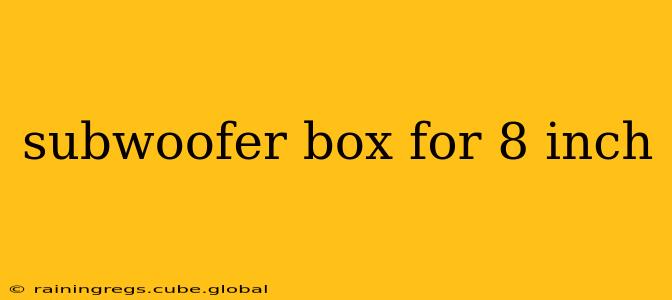Choosing the right subwoofer box is crucial for getting the best sound out of your 8-inch subwoofer. A poorly designed enclosure can severely hamper performance, resulting in weak bass, distorted sound, and even damage to your subwoofer. This guide will help you understand the key factors involved in building or choosing the optimal enclosure for your 8-inch driver.
What Type of Enclosure Should I Use for My 8-Inch Subwoofer?
This is often the first and most important question. The type of enclosure significantly impacts the subwoofer's performance and the overall sound signature. Common enclosure types include:
-
Sealed (Acoustic Suspension): These enclosures are airtight and provide tight, accurate bass with good transient response. They're generally smaller than ported enclosures, making them a good option for space-constrained applications. However, they typically produce less overall output at lower frequencies.
-
Ported (Bass Reflex): Ported boxes incorporate a port (tube) that allows air to move in and out, reinforcing the bass frequencies. This design generally produces louder bass output than sealed enclosures, particularly in the lower frequency range. However, the sound can be less precise and may exhibit some port noise if not designed properly.
-
Bandpass: These are more complex designs involving two chambers and two ports. They offer extremely high output in a narrow frequency range but can be difficult to design and tune correctly. They are generally not recommended for beginners.
The best type of enclosure for your 8-inch subwoofer depends on your priorities – loudness versus accuracy, size constraints, and your overall system goals.
What are the Dimensions of a Subwoofer Box for an 8-Inch Subwoofer?
There's no single answer to this question. The ideal dimensions depend on the specific subwoofer's parameters (such as its Vas – equivalent compliance volume), the desired enclosure type (sealed, ported, bandpass), and the tuning frequency (for ported enclosures).
You'll need to consult your subwoofer's specifications or use subwoofer box design software (many free options are available online) to determine the optimal dimensions for your chosen enclosure type. Incorrect dimensions can lead to significantly reduced performance or even damage to the subwoofer.
How Do I Calculate the Right Size Subwoofer Box?
Calculating the correct subwoofer box volume is critical. This isn't simply about cubic feet; the internal air space needs to match the subwoofer's parameters. As mentioned earlier, subwoofer box design software is invaluable here. These programs allow you to input your subwoofer's specifications (found in the manufacturer's documentation) and select the enclosure type. The software will then calculate the optimal internal dimensions. Failing to use this software could result in a poorly performing system.
What Materials Should I Use to Build a Subwoofer Box?
The material choice influences the box's resonance and overall sound quality. Common choices include:
-
Medium-Density Fiberboard (MDF): This is a popular choice due to its density, stiffness, and relatively low cost. It provides excellent damping properties, minimizing unwanted resonances.
-
Particle Board: Less expensive than MDF, but it's less dense and may not provide the same level of rigidity and damping.
-
Plywood: A strong option, but it can be more expensive and may require more skill to work with.
Choose appropriately thick material to ensure the box is rigid and resistant to vibrations. Thinner materials will resonate more and negatively impact sound quality.
What is the best port size and length for an 8-inch subwoofer ported enclosure?
The port size and length are crucial parameters for ported enclosures. Improper sizing can lead to port noise, reduced efficiency, or even damage to the subwoofer. Again, using subwoofer box design software is crucial. The software will calculate the optimal port dimensions based on your chosen tuning frequency and the subwoofer's parameters. These parameters will vary based on the specific 8-inch subwoofer model.
By carefully considering these factors and using appropriate design tools, you can build or select a subwoofer box that will allow your 8-inch subwoofer to perform at its best, delivering powerful and accurate bass. Remember, accuracy is key—don't cut corners when it comes to the design and construction of your subwoofer enclosure.
